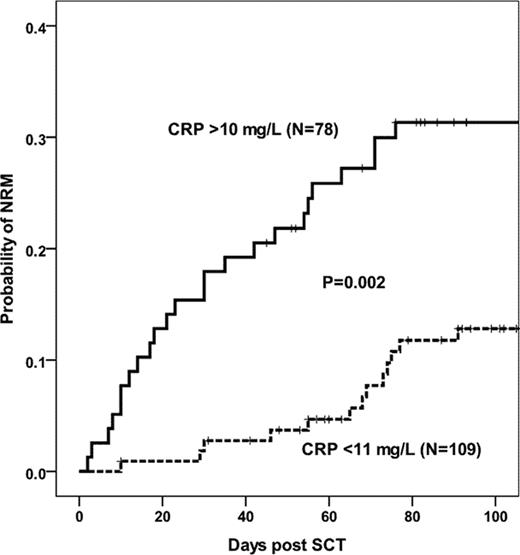Abstract
Abstract 1945
Identification of prognostic indicators which predict outcome of allogeneic stem cell transplantation (allo-SCT) is important for selection of patients who may benefit from the procedure. The European Group for Blood and Marrow Transplantation (EBMT) proposed a scoring system for CML which, after modification, also predicted outcomes for patients transplanted for other hematologic malignancies. We have recently shown that the level of C-reactive protein (CRP) measured shortly before transplantation is another important prognostic factor in patients undergoing myeloablative allo-SCT.
Patients and Methods: In this study we tested the value of CRP together with other known prognostic factors in 187 consecutive patients who underwent reduced intensity HCT in a single institution from 1995 through 2010. Disease stage was assessed in accordance with EBMT criteria. Preconditioning serum CRP levels were measured at a median of 15 days before stem cell infusion using a standard latex immunoassay. The median age at HCT of the 116 (62%) males and 71 (38%) females was 49 (range 15–67) years. Fifty seven patients (31%) were transplanted in early stage, 34 (18%) in intermediate stage and 96 (51%) in late stage of their disease. The diagnoses included: AML (n = 36; 19%), Hodgkin and non-Hodgkin lymphoma (n = 42; 23%), CML in first chronic phase (n = 29; 16 %), advanced phase CML (n = 21; 11%), MDS (n = 15; 8%), myeloma (n = 16; 9%), ALL (n = 7; 4 %), myelofibrosis (n = 5; 3%), and other (n = 16; 9 %). Patients were transplanted after conditioning containing fludarabine in combination with busulfan (n = 81, 43 %), cyclophosphamide (n = 37, 20 %), and melphalan (n = 47, 25 %); and lomustine, cytarabine, cyclophosphamide and etoposide (LACE) conditioning (n = 21; 11 %). Donors were HLA matched (n = 116; 62 %) and 1 – 2 antigen mismatched (n = 8; 4 %) siblings, matched (n = 46; 25 %) and 1–2 antigen mismatched unrelated (n = 11; 6%), and HLA haploidentical family members (n = 6; 3 %).
In univariate analysis, factors associated with day 100 non-relapse mortality (NRM) were disease stage, preconditioning CRP level and donor and recipient HLA match; whereas disease stage, CRP level, HLA match and number of previous allogeneic stem cell transplantations were associated with overall survival. In multivariate analysis only two factors showed independent prognostic value: disease stage (early / intermediate versus late) and CRP level (above versus below 10 mg/L). A CRP level > 10 and late disease stage predicted for higher NRM (RR: 1.83, CI 1.1 – 3.1, P =.021) and (RR: 1.78, CI 1.0 – 3.0, P =.037), and inferior survival (RR: 1.61, CI 1.1 – 2.4, P =.016) and (RR: 1.58, CI 1.1 – 2.3, P =.023) respectively. The day 100 NRM was 31% (95% CI 22 – 44) for patients with elevated CRP, and 13 % (95% CI 8–21) for those with normal CRP (P =.002; figure) and 20 % (95% CI 15–27) for the whole cohort. The 5-year survival was 41 % (95% CI 27 – 56) for patients with normal CRP, 21% (95% CI 12 – 35) for those with elevated CRP (P =.004) and 34 % (95% CI 25 – 44) for the whole cohort.
There is no obvious explanation for increased NRM and reduced survival in patients with elevated CRP before initiation of conditioning. Nevertheless our findings provide evidence that preconditioning level of CRP constitutes a key prognostic factor in allo-SCT and should be integrated into existing risk assessment tools when considering allo-SCT.
No relevant conflicts of interest to declare.
Author notes
Asterisk with author names denotes non-ASH members.


This feature is available to Subscribers Only
Sign In or Create an Account Close Modal